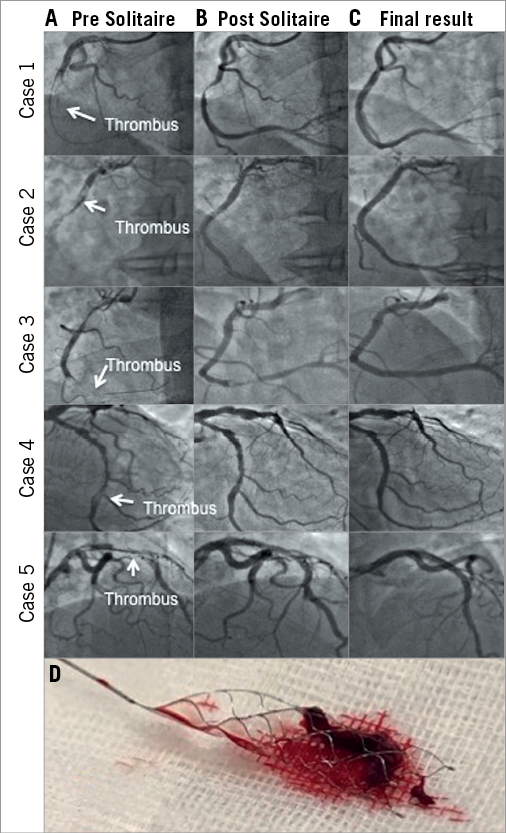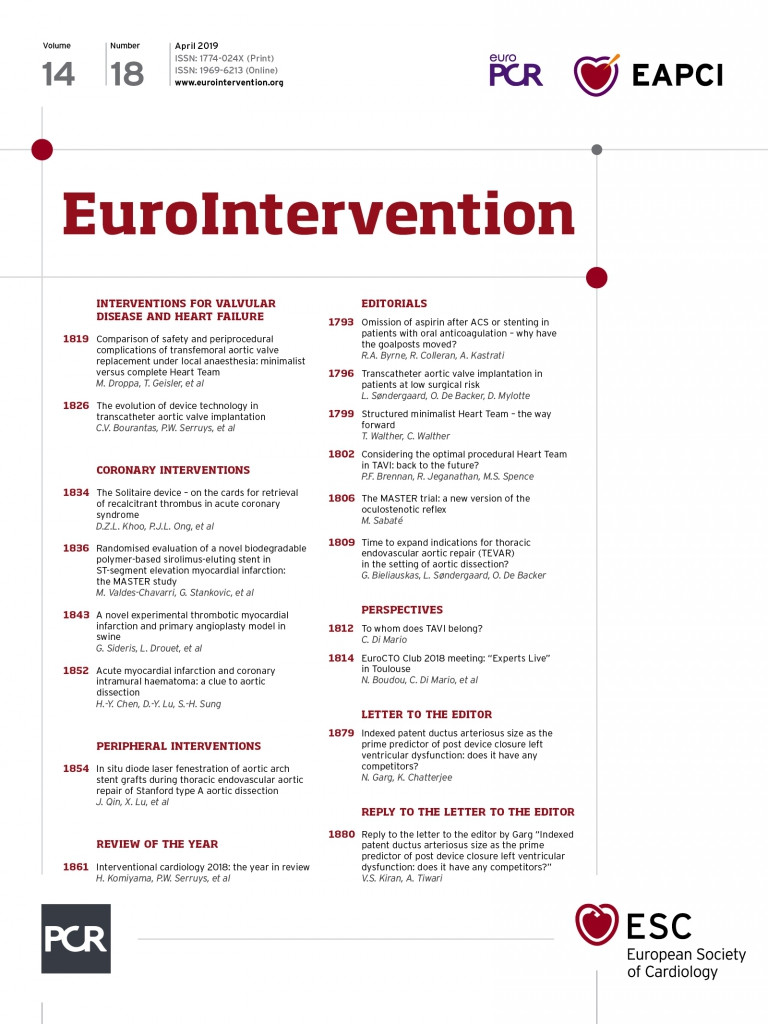

Figure 1. Five cases demonstrating reduction in thrombus load after Solitaire deployment. Column A demonstrates heavy thrombus burden in the coronary arteries of 5 patients before use of the Solitaire device. Column B demonstrates significant reduction in thrombus burden following use of the Solitaire device with improvement in distal flow. Column C demonstrates the final angiogram post stent placement at the conclusion of the procedures. Panel D shows a large organised thrombus extracted on the Solitaire device from case 2.
Large intracoronary thrombus poses a challenge during percutaneous coronary intervention; current strategies to reduce thrombus burden have limitations.
Stent retrievers are mechanical thrombectomy devices designed to extract large thrombus from occluded cerebral vessels. They have been shown to be safe and effective in acute ischaemic stroke11. Davalos A, Pereira VM, Chapot R, Bonafé A, Andersson T, Gralla J; Solitaire Group. Retrospective multicenter study of Solitaire FR for revascularisation in the treatment of acute ischemic stroke. Stroke. 2012;43:2699-705. ; however, experience of stent retrievers in the setting of intracoronary thrombus is limited. The Solitaire™ (Medtronic, Minneapolis, MN, USA) is a self-expanding nitinol stent-based system with a closed-cell design. Available in diameters of 4 and 6 mm, it accommodates vessels of 2.0-4.0 mm and 3.0-5.5 mm, respectively. For device delivery, a microcatheter (inner lumen of 0.021” or 0.027”) is delivered over a standard angioplasty wire distal to the thrombus. The wire is removed, and the device delivered into position via the microcatheter using the attached push wire. The microcatheter is withdrawn “unsheathing” the expanded Solitaire across the clot, establishing antegrade flow (Moving image 1, Moving image 2). After five minutes, allowing for clot integration, the microcatheter is advanced, capturing the proximal end of the device, partially collapsing it. To prevent systemic embolisation, the guide catheter is deep seated whilst the device is removed under constant aspiration on both the guide catheter and microcatheter.
The Solitaire was used in a series of seven patients presenting with acute coronary syndrome with heavy thrombus burden. Prior to using the Solitaire, all seven patients received intracoronary eptifibatide and underwent aspiration thrombectomy. One was treated with the AngioJet™ Peripheral Thrombectomy System (Boston Scientific, Marlborough, MA, USA) and another returned for deferred stenting. The Solitaire was used as a last resort when established methods failed to reduce thrombus and restore blood flow. Use of the device was associated with impressive reductions of TIMI thrombus grades from 4 or 5 to 1 or 0 with improvement in TIMI flow by 1 to 2 grades as shown in Figure 1 (Moving image 3-Moving image 8).
The Solitaire was highly efficacious as a bail-out strategy for thrombectomy in this small cohort of patients with a high burden of persistent thrombus where conventional means of treatment failed. It was highly deliverable via the microcatheter and safe for use with no intraprocedural or post-procedural complications. Given these promising findings, further studies to assess clinical and safety outcomes of this mode of thrombectomy in acute coronary syndrome should be explored.
Conflict of interest statement
The authors have no conflicts of interest to declare.
Supplementary data
Moving image 1. A deployed Solitaire device in the RCA.
Moving image 2. A deployed Solitaire device in the LAD.
Moving image 3. Large residual thrombus in the RCA following use of intracoronary IIb/IIIa inhibitors and thrombus aspiration.
Moving image 4. Significant reduction in thrombus burden and improvement in coronary flow after use of the Solitaire device in the RCA.
Moving image 5. RCA final results after PCI.
Moving image 6. Large residual thrombus in the proximal LAD following use of intracoronary IIb/IIIa inhibitors and thrombus aspiration.
Moving image 7. Significant reduction in thrombus burden and improvement in coronary flow after use of the Solitaire device in the LAD.
Moving image 8. LAD final results after PCI.
Supplementary data
To read the full content of this article, please download the PDF.
Moving image 1. A deployed Solitaire device in the RCA
Moving image 2. A deployed Solitaire device in the LAD.
Moving image 3. Large residual thrombus in the RCA following use of intracoronary IIb/IIIa inhibitors and thrombus aspiration.
Moving image 4. Significant reduction in thrombus burden and improvement in coronary flow after use of the Solitaire device in the RCA.
Moving image 5. RCA final results after PCI.
Moving image 6. Large residual thrombus in the proximal LAD following use of intracoronary IIb/IIIa inhibitors and thrombus aspiration.
Moving image 7. Significant reduction in thrombus burden and improvement in coronary flow after use of the Solitaire device in the LAD.
Moving image 8. LAD final results after PCI.

